现实生活中常会看到这样的一种集合:IP地址与主机名,身份证号与个人,系统用户名与系统用户对象等,这种一一对应的关系,就叫做映射。Java提供了专门的集合类用来存放这种对象关系的对象,即java.util.Map接口。
查看Map接口描述,发现Map接口下的集合与Collection接口下的集合,它们存储数据的形式不同。
Collection中的集合,元素是孤立存在的(理解为单身),向集合中存储元素采用一个个元素的方式存储。Map中的集合,元素是成对存在的(理解为夫妻)。每个元素由键与值两部分组成,通过键可以找对所对应的值。Collection中的集合称为单列集合,Map中的集合称为双列集合。Map中的集合不能包含重复的键,值可以重复;每个键只能对应一个值。通过查看Map接口描述,看到Map有多个子类,这里我们主要讲解常用的HashMap集合、LinkedHashMap集合。
JDK1.8之前:数组+单向链表
JDK1.8之后:数组+单向链表|红黑树(链表的长度超过8):提高查询的速度
多线程,不同步,快
tips:Map接口中的集合都有两个泛型变量<K,V>,在使用时,要为两个泛型变量赋予数据类型。两个泛型变量<K,V>的数据类型可以相同,也可以不同。
Map接口中定义了很多方法,常用的如下:
public V put(K key, V value): 把指定的键与指定的值添加到Map集合中。public V remove(Object key): 把指定的键 所对应的键值对元素 在Map集合中删除。key存在,返回被删除的值;key不存在,返回null。public V get(Object key) 根据指定的键,在Map集合中获取对应的值。key存在,返回对应的value值;key不存在,返回null。boolean containsKey(Object key) 判断集合中是否包含指定的键。含返回true,不包含返回false。public Set<K> keySet(): 获取Map集合中所有的键,存储到Set集合中。public Set<Map.Entry<K,V>> entrySet(): 获取到Map集合中所有的键值对对象的集合(Set集合)。Map接口的方法演示
public class MapDemo {
public static void main(String[] args) {
//创建 map对象
HashMap<String, String> map = new HashMap<String, String>();
// 添加元素到集合
map.put("黄晓明", "杨颖");
map.put("A", "B");
map.put("邓超", "孙俪");
System.out.println(map);
map.put("黄晓明", "Angelababy"); //键的值被更新,返回旧值(但此处没有接收)
// 移除 String remove(String key)
System.out.println(map.remove("邓超"));
System.out.println(map);
// 查看
System.out.println(map.get("黄晓明"));
System.out.println(map.get("邓超"));
// 判断Key是否存在
boolean b = map.containsKey("赵丽颖");
System.out.println("b:"+b); //b:false
}
}
tips:
使用put方法时,若指定的键(key)在集合中没有,则没有这个键对应的值,返回null,并把指定的键值添加到集合中;
若指定的键(key)在集合中存在,则返回值为集合中键对应的值(该值为替换前的值),并把指定键所对应的值,替换成指定的新值。
键找值方式:即通过元素中的键,获取键所对应的值
分析步骤:
keySet()get(K key)代码演示:
public class MapDemo01 {
public static void main(String[] args) {
//1.创建Map集合对象 并 加元素到集合
HashMap<String, String> map = new HashMap<String,String>();
map.put("胡歌", "霍建华");
map.put("郭德纲", "于谦");
map.put("薛之谦", "大张伟");
//2. 获取所有的键 获取键集
Set<String> keys = map.keySet();
//3.1 使用迭代器遍历Set集合
Iterator<String> it = set.iterator();
while (it.hasNext()){
String key = it.next();
// 通过Map集合中的方法get(key),通过key找到value
Integer value = map.get(key);
System.out.println(key+"="+value);
}
//3.2 遍历键集 得到 每一个键
for (String key : keys) { // for(String key : map.keySet())
//获取对应值
String value = map.get(key);
System.out.println(key+"对应的是:"+value);
}
}
}
遍历图解:

Map中存放的是两种对象,一种称为key(键),一种称为value(值),它们在Map中是一一对应关系,这一对对象又称做Map中的一个Entry(项)。Entry将键值对的对应关系封装成了对象。即键值对对象,这样我们在遍历Map集合时,就可以从每一个键值对(Entry)对象中获取对应的键与对应的值。
既然Entry表示了一对键和值,那么也同样提供了获取对应键和对应值得方法:
public K getKey():获取Entry对象中的键。public V getValue():获取Entry对象中的值。在Map集合中也提供了获取所有Entry对象的方法:
public Set<Map.Entry<K,V>> entrySet(): 获取到Map集合中所有的键值对对象的集合(Set集合)。
键值对方式:即通过集合中每个键值对(Entry)对象,获取键值对(Entry)对象中的键与值。
操作步骤与图解:
entrySet()。getkey() getValue()public class MapDemo02 {
public static void main(String[] args) {
// 创建Map集合对象
Map<String, String> map = new HashMap<String,String>();
// 添加元素到集合
map.put("胡歌", "霍建华");
map.put("郭德纲", "于谦");
map.put("薛之谦", "大张伟");
// 获取 所有的 entry对象 entrySet
Set<Map.Entry<String,String>> entrySet = map.entrySet();
//1. 使用迭代器遍历Set集合
Iterator<Map.Entry<String, Integer>> it = set.iterator();
while(it.hasNext()){
Map.Entry<String, Integer> entry = it.next();
//3.使用Entry对象中的方法getKey()和getValue()获取键与值
String key = entry.getKey();
Integer value = entry.getValue();
System.out.println(key+"="+value);
}
//2. 增强for遍历得到每一个entry对象
for (Map.Entry<String, String> entry : entrySet) {
// 解析
String key = entry.getKey();
String value = entry.getValue();
System.out.println(key+"对应的是:"+value);
}
}
}
遍历图解:
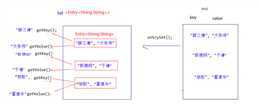
tips:Map集合不能直接使用迭代器或者foreach进行遍历。但是转成Set之后就可以使用了。
练习:每位学生(姓名,年龄)都有自己的家庭住址。那么,既然有对应关系,则将学生对象和家庭住址存储到map集合中。学生作为键, 家庭住址作为值。
注意,学生姓名相同并且年龄相同视为同一名学生。
编写学生类:
public class Student {
private String name;
private int age;
public Student() {
}
public Student(String name, int age) {
this.name = name;
this.age = age;
}
public String getName() {
return name;
}
public void setName(String name) {
this.name = name;
}
public int getAge() {
return age;
}
public void setAge(int age) {
this.age = age;
}
@Override
public boolean equals(Object o) { // ??
if (this == o)
return true;
if (o == null || getClass() != o.getClass())
return false;
Student student = (Student) o;
return age == student.age && Objects.equals(name, student.name);
}
@Override
public int hashCode() { // ??
return Objects.hash(name, age);
}
}
编写测试类:
public class HashMapTest {
public static void main(String[] args) {
//1,创建Hashmap集合对象。
Map<Student,String>map = new HashMap<Student,String>();
//2,添加元素。
map.put(newStudent("lisi",28), "上海");
map.put(newStudent("wangwu",22), "北京");
map.put(newStudent("zhaoliu",24), "成都");
map.put(newStudent("zhouqi",25), "广州");
map.put(newStudent("wangwu",22), "南京");
//3,取出元素。键找值方式
Set<Student>keySet = map.keySet();
for(Student key: keySet){
Stringvalue = map.get(key);
System.out.println(key.toString()+"....."+value);
}
}
}
java.util.LinkedHashMap集合来存放。HashMap保证成对元素唯一,并且查询速度很快,可是成对元素存放进去是没有顺序的,那么我们要保证有序,还要速度快怎么办呢?
在HashMap下面有一个子类LinkedHashMap,它是链表和哈希表(记录元素的顺序)组合的一个数据存储结构。
java.util.LinkedHashMap<K,V> entends HashMap<K,V>
public class Demo01LinkedHashMap {
public static void main(String[] args) {
HashMap<String,String> map = new HashMap<>();
map.put("a","a");
map.put("c","c");
map.put("b","b");
map.put("a","d");
System.out.println(map);// key不允许重复,无序 {a=d, b=b, c=c}
LinkedHashMap<String,String> linked = new LinkedHashMap<>();
linked.put("a","a");
linked.put("c","c");
linked.put("b","b");
linked.put("a","d");
System.out.println(linked);// key不允许重复,有序 {a=d, c=c, b=b}
}
}
java.util.Hashtable<K,V>集合 implements Map<K,V>接口
1)Hashtable:底层也是一个哈希表,是一个线程安全的集合,是单线程集合,速度慢
2)HashMap:底层是一个哈希表,是一个线程不安全的集合,是多线程的集合,速度快
3)HashMap集合(之前学的所有的集合):可以存储null值,null键
4)Hashtable集合,不能存储null值,null键
5)Hashtable和Vector集合一样,在jdk1.2版本之后被更先进的集合(HashMap,ArrayList)取代了
6)Hashtable的子类Properties依然活跃在历史舞台
7)Properties集合是一个唯一和IO流相结合的集合
public class Demo02Hashtable {
public static void main(String[] args) {
HashMap<String,String> map = new HashMap<>();
map.put(null,"a");
map.put("b",null);
map.put(null,null);
System.out.println(map);//{null=null, b=null}
Hashtable<String,String> table = new Hashtable<>();
//table.put(null,"a");//NullPointerException
//table.put("b",null);//NullPointerException
//table.put(null,null);//NullPointerException
}
}
需求:
计算一个字符串中每个字符出现次数。
分析:
代码:
public class MapTest {
public static void main(String[] args) {
//友情提示
System.out.println("请录入一个字符串:");
String line = new Scanner(System.in).nextLine();
// 定义 每个字符出现次数的方法
findChar(line);
}
private static void findChar(String line) {
//1:创建一个集合 存储 字符 以及其出现的次数
HashMap<Character, Integer> map = new HashMap<Character, Integer>();
//2:遍历字符串
for (int i = 0; i < line.length(); i++) { //?? 或者使用 for(char c :str.toCharArray())
char c = line.charAt(i);
//判断 该字符 是否在键集中
if (!map.containsKey(c)) {//说明这个字符没有出现过
//那就是第一次
map.put(c, 1);
} else {
//先获取之前的次数
Integer count = map.get(c);
//count++;
//再次存入 更新
map.put(c, ++count);
}
}
System.out.println(map);
}
}
通常,我们在代码中创建一个集合(例如,List 或 Set ),并直接用一些元素填充它。 实例化集合,几个 add方法 调用,使得代码重复。
public class Demo01 {
public static void main(String[] args) {
List<String> list = new ArrayList<>();
list.add("abc");
list.add("def");
list.add("ghi");
System.out.println(list);
}
}
Java 9,添加了几种集合工厂方法,更方便创建少量元素的集合、map实例。新的List、Set、Map的静态工厂方法可以更方便地创建集合的不可变实例。
List接口,Set接口,Map接口:里边增加了一个静态的方法of,可以给集合一次性添加多个元素
static <E> List<E> of?(E... elements)
使用前提:当集合中存储的元素的个数已经确定了,不在改变时使用
注意:
1.of方法只适用于List接口、Set接口、Map接口,不适用于接口的实现类。
2.of方法的返回值是一个不能改变的集合,集合不能再使用add、put方法添加元素,会抛出异常。
3.Set接口和Map接口在调用of方法的时候,不能有重复的元素,否则会抛出异常。
例子:
public class HelloJDK9 {
public static void main(String[] args) {
Set<String> str1=Set.of("a","b","c");
//?? str1.add("c");这里编译的时候不会错,但是执行的时候会报错,因为是不可变的集合
//?? Set<String> set = Set.of("a", "b", "a", "c", "d"); //?? IllegalArgumentException:非法参数异常,有重复的元素
System.out.println(str1);
Map<String,Integer> str2=Map.of("a",1,"b",2);
System.out.println(str2);
//?? Map<String, Integer> map = Map.of("张三", 18, "李四", 19, "王五", 20,"张三",19); //?? IllegalArgumentException:非法参数异常,有重复的元素
/??/map.put("赵四",30); //?? UnsupportedOperationException:不支持操作异常
List<String> str3=List.of("a","b");
System.out.println(str3);
//?? list.add("w"); //?? UnsupportedOperationException:不支持操作异常
}
}
需要注意以下两点:
1: of()方法只是Map,List,Set这三个接口的静态方法,其父类接口和子类实现并没有这类方法,比如 HashSet,ArrayList等待;
2: 返回的集合是不可变的;
使用IDEA的断点调试功能,查看程序的运行过程

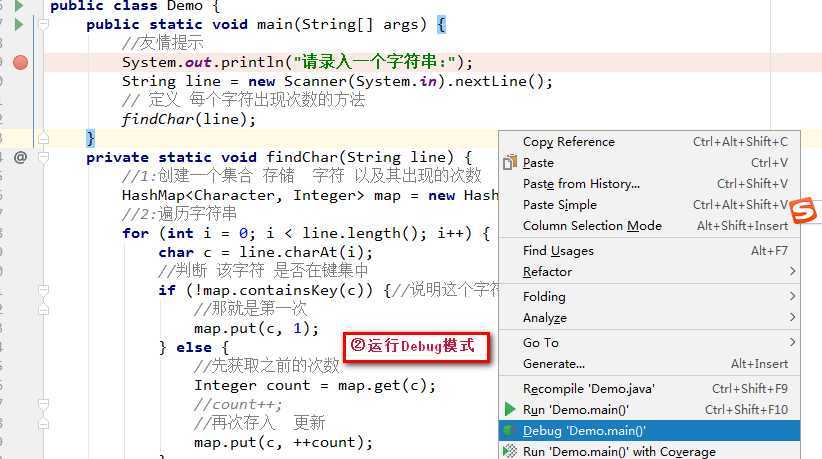

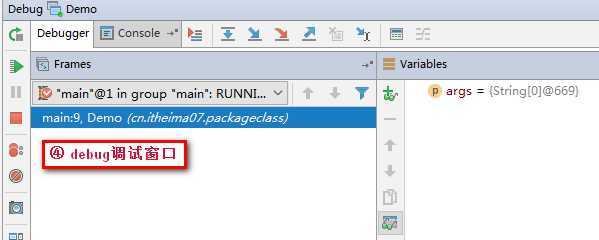
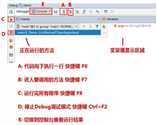
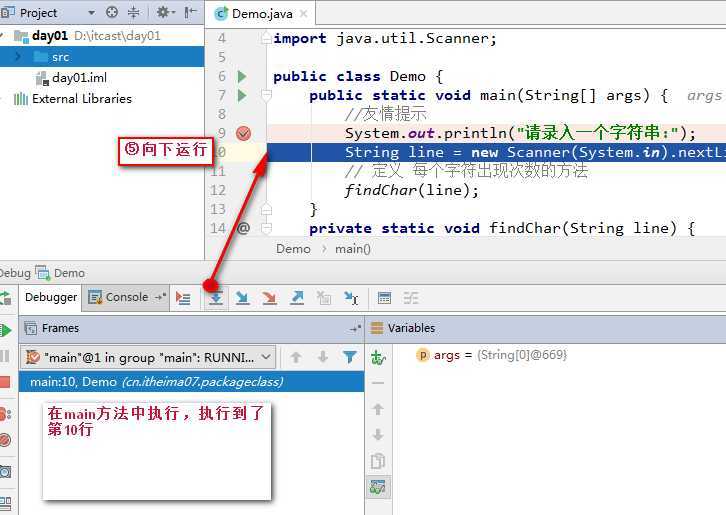

快捷键F8,程序继续向后执行,执行键盘录入操作,在控制台录入数据 ababcea

回车之后效果:

调试界面效果:

此时到达findChar方法,快捷键F7,进入方法findChar
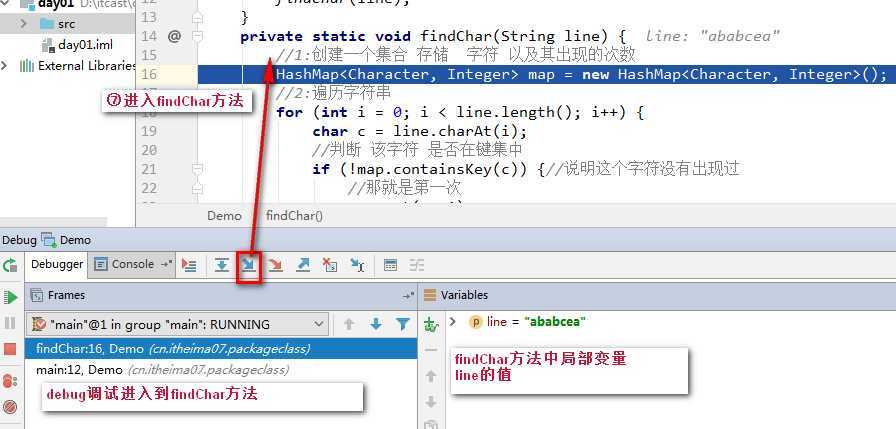

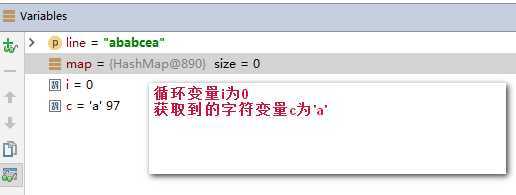

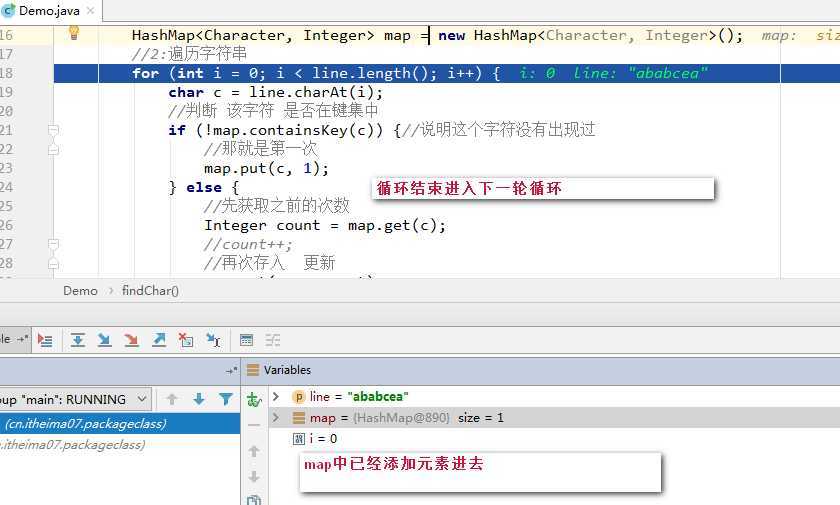

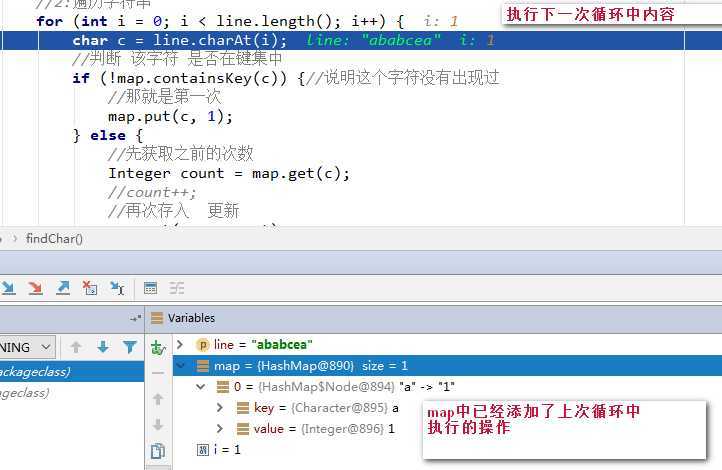
按照斗地主的规则,完成洗牌发牌的动作。

具体规则:
规则:手中扑克牌从大到小的摆放顺序:大王,小王,2,A,K,Q,J,10,9,8,7,6,5,4,3

完成数字与纸牌的映射关系:
使用双列Map(HashMap)集合,完成一个数字与字符串纸牌的对应关系(相当于一个字典)。
通过数字完成洗牌发牌
将每个人以及底牌设计为ArrayList
存放的过程中要求数字大小与斗地主规则的大小对应。
将代表不同纸牌的数字分配给不同的玩家与底牌。
通过Map集合找到对应字符展示。
通过查询纸牌与数字的对应关系,由数字转成纸牌字符串再进行展示。
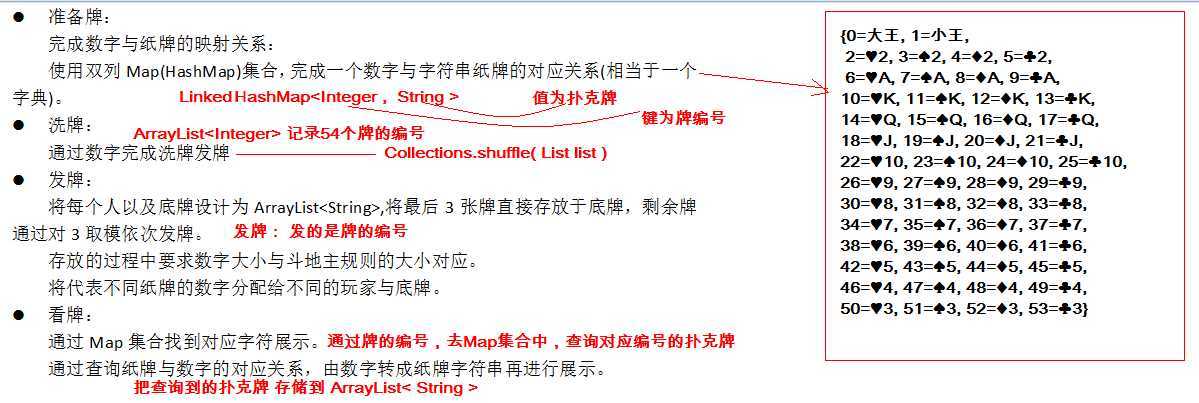
public class Poker {
public static void main(String[] args) {
/*
* 1组装54张扑克牌
*/
// 1.1 创建Map集合存储
HashMap<Integer, String> pokerMap = new HashMap<Integer, String>();
// 1.2 创建 花色集合 与 数字集合
ArrayList<String> colors = new ArrayList<String>();
ArrayList<String> numbers = new ArrayList<String>();
// 1.3 存储 花色 与数字
Collections.addAll(colors, "?", "?", "?", "?");
Collections.addAll(numbers, "2", "A", "K", "Q", "J", "10", "9", "8", "7", "6", "5", "4", "3");
// 设置 存储编号变量
int count = 1;
pokerMap.put(count++, "大王");
pokerMap.put(count++, "小王");
// 1.4 创建牌 存储到map集合中
for (String number : numbers) {
for (String color : colors) {
String card = color + number;
pokerMap.put(count++, card);
}
}
/*
* 2 将54张牌顺序打乱
*/
// 取出编号 集合
Set<Integer> numberSet = pokerMap.keySet(); //??
// 因为要将编号打乱顺序 所以 应该先进行转换到 list集合中
ArrayList<Integer> numberList = new ArrayList<Integer>();
numberList.addAll(numberSet); //??
// 打乱顺序
Collections.shuffle(numberList);
// 3 完成三个玩家交替摸牌,每人17张牌,最后三张留作底牌
// 3.1 发牌的编号
// 创建三个玩家编号集合 和一个 底牌编号集合
ArrayList<Integer> noP1 = new ArrayList<Integer>();
ArrayList<Integer> noP2 = new ArrayList<Integer>();
ArrayList<Integer> noP3 = new ArrayList<Integer>();
ArrayList<Integer> dipaiNo = new ArrayList<Integer>();
// 3.2发牌的编号
for (int i = 0; i < numberList.size(); i++) {
// 获取该编号
Integer no = numberList.get(i);
// 发牌
// 留出底牌
if (i >= 51) {
dipaiNo.add(no);
} else {
if (i % 3 == 0) {
noP1.add(no);
} else if (i % 3 == 1) {
noP2.add(no);
} else {
noP3.add(no);
}
}
}
// 4 查看三人各自手中的牌(按照牌的大小排序)、底牌
// 4.1 对手中编号进行排序 sort默认是升序排序
Collections.sort(noP1);
Collections.sort(noP2);
Collections.sort(noP3);
Collections.sort(dipaiNo);
// 4.2 进行牌面的转换
// 创建三个玩家牌面集合 以及底牌牌面集合
ArrayList<String> player1 = new ArrayList<String>();
ArrayList<String> player2 = new ArrayList<String>();
ArrayList<String> player3 = new ArrayList<String>();
ArrayList<String> dipai = new ArrayList<String>();
// 4.3转换
for (Integer i : noP1) {
// 4.4 根据编号找到 牌面 pokerMap
String card = pokerMap.get(i);
// 添加到对应的 牌面集合中
player1.add(card);
}
for (Integer i : noP2) {
String card = pokerMap.get(i);
player2.add(card);
}
for (Integer i : noP3) {
String card = pokerMap.get(i);
player3.add(card);
}
for (Integer i : dipaiNo) {
String card = pokerMap.get(i);
dipai.add(card);
}
//4.5 查看
System.out.println("令狐冲:"+player1);
System.out.println("石破天:"+player2);
System.out.println("鸠摩智:"+player3);
System.out.println("底牌:"+dipai);
}
}
原文:https://www.cnblogs.com/miaomiaowu/p/13111657.html